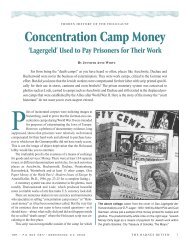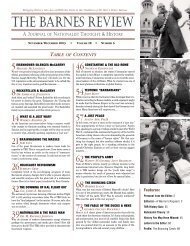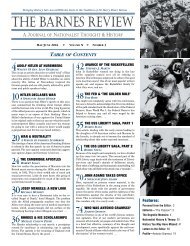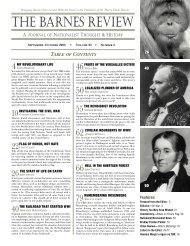Create successful ePaper yourself
Turn your PDF publications into a flip-book with our unique Google optimized e-Paper software.
PAGE 34 the barnes review MAY/JUNE<br />
ships also seemed an ideal long-range platform<br />
from which to hunt Nazi U-boats in<br />
the Caribbean and South Atlantic—the<br />
Navy built some large dirigibles in the<br />
1930s, though they proved unwieldy. In<br />
fact, several were wrecked in storms, with<br />
tragic loss of life, before the next war even<br />
started. <strong>The</strong> Navy switched to blimps.<br />
Still, the fact remained: Only American<br />
dirigibles and blimps could be floated with<br />
fireproof helium. America jealously guarded<br />
her helium monopoly, refusing to sell the<br />
stuff to Nazi Germany, whose airships thus<br />
remained dependent on highly flammable<br />
hydrogen.<br />
In 1929, imagining future wars in which<br />
the skies would grow dark with clouds of<br />
airships, Congress first appropriated mo -<br />
ney to make the storage and marketing of<br />
American helium a government operation.<br />
By 1960, the Helium Reserve program had<br />
taken on a life of its own, purchasing 4 billion<br />
cubic feet per year—10 times the annual<br />
rate of use—and paying private industry<br />
to build huge refining and underground<br />
storage facilities for the inert gas, in the<br />
Texas panhandle. To do that, of course,<br />
Washington had to guarantee a higherthan-market<br />
price: $35 per 1,000 cubic feet,<br />
up from the previous $15. <strong>The</strong> federal government<br />
has been buying surplus production<br />
to maintain a similarly artificial high<br />
price ever since.<br />
Today, the Bureau of Mines loses $100<br />
million per year storing a billion dollars<br />
worth of this substance—enough to meet<br />
world demand for more than a century.<br />
Over the years, the government’s helium<br />
operation has run up an estimated debt of<br />
$1.4 billion. <strong>The</strong> military has not commissioned<br />
a new zeppelin or blimp for 50 years.<br />
Arguably the most important zeppelin<br />
ever built, the first Graf Zeppelin (LZ-127)<br />
proved what could be done with a properly<br />
run and maintained zeppelin. <strong>The</strong> Graf was<br />
the ultimate in passenger air travel for the<br />
day and could put any modern commercial<br />
jet to shame when it comes to comfort and<br />
style. <strong>The</strong> Graf was first walked out of her<br />
hangar on September 18, 1928. She would<br />
fly farther than any other zeppelin manufactured<br />
before or since.<br />
First flown in tests on March 4, 1936,<br />
the Hindenburg made its first flight on<br />
March 26 of the same year. She would<br />
make several awe-inspiring flights before<br />
her destruction at Lakehurst, New Jersey.<br />
John Tiffany is the editor of THE<br />
BARNES REVIEW and a longtime Revis -<br />
ionist scholar.<br />
Count Ferdinand von Zeppelin is third from left as he poses with members of the<br />
crew of his airship L-31 in this 1916 photograph. Hugo Eckener, director of the<br />
German Aerial Navigation Company, destined to become the world’s most skilled<br />
airship captain and an expert promoter of “zeps,” is the bearded crewman just to<br />
the left of the count and partly obstructed by the count’s hat.<br />
<strong>The</strong> last of a dying breed in difficult<br />
times, the most forgotten of the zeppelins is<br />
the Graf Zeppelin II (LZ-130), completed in<br />
1938, near the outbreak of World War II.<br />
Even though it included many modern construction<br />
advances, the LZ-130 never<br />
gained much publicity and was to be the<br />
last of the gigantic passenger dirigibles of<br />
its era. (Note that the Graf II was built<br />
after the Hindenburg disaster.) ❖<br />
FOOTNOTE:<br />
1 <strong>The</strong> very word “dirigible” comes from the<br />
French, meaning “steerable” or “directable.” We<br />
understand it to mean a steerable lighter-than-air<br />
craft.<br />
BIBLIOGRAPHY:<br />
WEB SITES:<br />
nguworld.com/vindex/<br />
webleyweb.com/tle/le960506.html<br />
ciderpresspottery.com/ZLA.html<br />
cargolifter.com<br />
speedvision.com/pub/articles/aviation/02inews/00<br />
0628a.html<br />
trivia.about.com/games/trivia/gi/dynamic/offsite.htm?site=http://people.frankfurt.netsurf.de/Jen.<br />
Schenkenberger/bild%5F00002%5Flz129.htm<br />
geocities.com/gene_moutoux/Zep<br />
pelin.htm<br />
goldcoasters.com/tips/c0037fs009.<br />
html<br />
germanculture.about.com/culture/germanculture/library/weekly/aa062000b.htm<br />
nara.gov/nara/legislative/house_guide/hgch23ci.<br />
html<br />
sciencenews.org/sn_arch/6_15_96/timeline.htm<br />
BOOKS:<br />
Ambers, Henry J., <strong>The</strong> Dirigible and the Future,<br />
Eidelweiss Press, Massapequa Park, New York,<br />
1981.<br />
Andrews, Solomon, <strong>The</strong> Aereon, or Flying-Ship,<br />
J.F. Trow & Co., New York, 1866.<br />
Archbold, Rick, Hindenburg: An Illustrated<br />
History, Warner Books, New York, 1994.<br />
Clark, Basil, <strong>The</strong> History of Airships, St.<br />
Martin’s Press, New York, 1964.<br />
Collier, Basil, <strong>The</strong> Airship: A History, G.P.<br />
Putnam’s Sons, New York, 1974.<br />
Duggins, Don, <strong>The</strong> Complete Book of Airships,<br />
Tab Books, Blue Ridge Summit, Pa., 1980.<br />
Gibbs-Smith, Charles H., <strong>The</strong> Invention of the<br />
Aeroplane (1799-1909), Taplinger Publishing Co.,<br />
New York, 1965.<br />
Glines, Carroll, (ed.), Lighter-Than-Air Flight, F.<br />
Watts, New York, 1965.<br />
Harper, Henry, <strong>The</strong> Evolution of Flying<br />
Machines, Hutchins & Co., London, 1930.<br />
Harris, Sherwood, <strong>The</strong> First to Fly: Aviation’s<br />
Pioneer Days, Simon & Schuster, New York, 1970.<br />
Hearne, R.P., Zeppelins and Super-Zeppelins,<br />
John Lane, London, 1916.<br />
Hylander, Clarence J., Cruisers of the Air: <strong>The</strong><br />
Story of Lighter-Than-Air Craft, from the Days of<br />
Roger Bacon to the Making of the ZRS-4, Macmillan<br />
Co., New York, 1931.<br />
Ryan, Craig, <strong>The</strong> Pre-Astronauts: Manned<br />
Ballooning on the Threshold of Space, Naval<br />
Institute Press, Annapolis, Maryland, 1995.<br />
Tanaka, Shelley, <strong>The</strong> Disaster of the<br />
Hindenburg, Madison Press Books, Toronto,<br />
Ontario, 1993.<br />
Ventry, Lord, and Kolésnik, Eugène M., Jane’s<br />
Pocket Book of Airships, Collier Books, New York,<br />
1977.<br />
Wood, Peter, When Zeppelins Flew, Time-Life<br />
Books, New York, 1969.
















